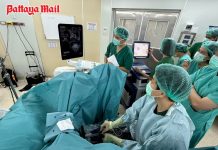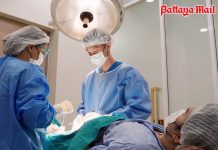It is a couple of years since I wrote about SuperSight Surgery. This is a revolutionary procedure that has changed the lives of many in Pattaya, and as the news traveled throughout the world, the world traveled to Pattaya to have this life-changing operation. In fact, two of my doctor friends here in Pattaya have had this done, and both are very happy with the end result.
So, are you over 50 and using spectacles to read this article? Do you hate your reading glasses? If so, help is at hand! This is SuperSight Surgery (not to be confused with LASIK).
SuperSight Surgery is in the forefront of ophthalmic procedures. The world leader is Dr. Somchai Trakoolshokesatian and he consults out of the Bangkok Hospital Pattaya. He has been carrying out this procedure for nine years on over 3000 patients and has perfected the technique to ensure good results for each individual patient, with success and satisfaction rates of almost 100 percent.
Unfortunately, the need for reading glasses is a natural progression of aging. The first signs are the fact that you have to hold this newspaper further away to be able to read it, and you also find that you need a good light to be able to see the words clearly. Eventually you succumb and buy reading glasses, to which you become a slave. Eventually you keep one pair at home, another in the car and another in the office. And your nose gets funny indentations either side of the bridge, where the spectacles settle.
As you get older, all the ‘elastic’ tissues in your body become less pliable. Knees, lower back, fingers, neck, the list is endless. However, you have to add to that list, the lens in your eye. The fiddly little lens, supplied at birth as a standard feature, does not have a fixed focus, but under your control you can make it focus close up (to read) and then also focus at a distance. The way you do this is by ‘bending’ the lens to be able to focus on near objects. Unfortunately, as the lens becomes less pliable, the muscles in your eye become unable to bend the stiffening lens enough to produce the near point focus. The near point moves further away, until you have run out of arms, as described previously. We call this condition ‘Presbyopia’.
Unfortunately there is yet another result of aging that occurs in the lens of the eye. This is a gradual cloudiness which lowers the visual acuity, and eventually brings on blindness. This is called a cataract. So not only can you not see well enough to read the magazines, but you also begin to lose your distance vision. Welcome to the wonderful world of white sticks and Labrador dogs. Even the World Health Organization says there are currently between 12 and 15 million people blind from cataracts.
The initial method of treating this was by removal of the now optically inefficient natural lens, and attempting to return some usable vision through the introduction of very thick and heavy spectacles placed before the eye. These glasses looked as if the lenses were made from the bottom of Coca-Cola bottles (registered trade mark and all), and were just as heavy. The patient could see again, but reading required even thicker lenses, or hand-held magnifying glasses. Not all that comfortable, but beats the alternative.
So we come to the latest development in intra-ocular lenses (IOLs), where the hardened lenses are replaced by other, very special lenses. These can be focusable lenses, under the control of the patient’s own intra-ocular muscles, or multi-focal lenses, with the brain picking the necessary focus as required. This is SuperSight Surgery and with these lenses you can read your golf scorecard with your near vision, focus on the ball on the tee with your intermediate vision and then using your distance vision watch it gently arcing into the water hazard. (These new IOLs can improve your sight, but not your golf.)
If you want to know more, contact Dr Somchai and reduce your dependence on contact lenses or glasses. You will be amazed.




